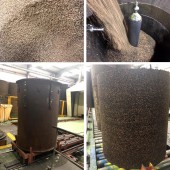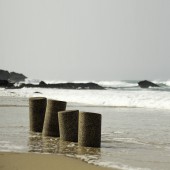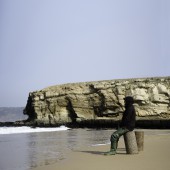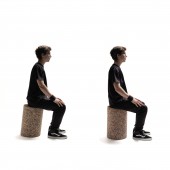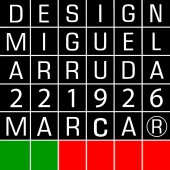Cork Trunk Bench by Miguel Arruda |
Home > Winners > #79613 |
 |
|
||||
| DESIGN DETAILS | |||||
| DESIGN NAME: Cork Trunk PRIMARY FUNCTION: Bench INSPIRATION: Derives from the observation of four factors.The observation of nature such as the cork oak tree, recycled cork and the technological Process and ergonomics.The way the tree anchors itself on the ground and its chromatism were crucial in the process. The recycling of the cork and plastic as materials.The technological process was motivated by the creative concept; the cylinder produced as final waste, instead of being destroyed,is recovered.The ground interaction allowing the interchangeability of its functional possibilities. UNIQUE PROPERTIES / PROJECT DESCRIPTION: The cork agglomerate, results from a composition of cork granulate with polyurethane,both recycled and consolidated through compression, heat and the use of a binder inside a metal cylinder.This material is used in subfloors, leaving as waste a cylinder that is now used to make the Cork Trunk.The ten degree cut of one of his faces allows two possible configurations of seated position to different functions,providing special support for effective comfort. OPERATION / FLOW / INTERACTION: The cylinder body of the Cork Trunk is cut on one face at an angle of ten degrees allowing it to have two positions towards the ground, the first is vertical, being the upper part of the cylinder, intended for the sitting position, at a ten degrees angle relatively to the horizontal plane and a second oblique to the ground at eighty-five degrees with the upper surface of the cylinder,intended for seating, at an angle of ten degrees,providing a special support to the coccyx for effective comfort. PROJECT DURATION AND LOCATION: The project started in February 2017 in Lisbon and Finished in August 2018 in Lisbon. FITS BEST INTO CATEGORY: Furniture Design |
PRODUCTION / REALIZATION TECHNOLOGY: The cork agglomerate, results from a composition of cork granulate of particle size 2-3 mm with polyurethane, both recycled and consolidated through the use of a binder.This cork agglomerate is launched inside a metal cylinder with dimensions of, 1000 mm in diameter and a height of 1100 mm where it is subject to a certain pressure and temperature that allows it to reach at the end of its production a compression strength of 100, a compression recovery of 70 and a specific weight of 230kg/m3. This cylindrical block resulting from the above operation reaches the final dimensions of 990mm in diameter and a height of 1067mm. Its circular lamination is then used to produce rolls of various thicknesses, used in particular in subfloors, leaving as a final waste a cylinder of 300mm diameter with 1067mm height. This cylinder that would normally be subject to grinding for new recycling is used for the production of Cork Trunk benches. This cylinder is cut on one of its faces at an angle of 10° allowing it to have two types of positioning towards the ground, the first vertical being the upper part of the cylinder intended for the sitting position at a relatively 10° angle to the horizontal plane and a second oblique to the ground at an angle of 85° with the upper zone of the cylinder intended for seating at an angle of 10° to the horizontal plane. SPECIFICATIONS / TECHNICAL PROPERTIES: Width 300 mm x Height 600 mm and Width 450 mm x Height 600 mm TAGS: Bench, Cork, Trunk, Chair, Seat, Recycled RESEARCH ABSTRACT: The cork agglomerate manufactured by the Amorim Composits Plant, under reference number 5085, results from a composition of cork granulate particle size 2-3 m, with polyurethane, both recycled and consolidated through the use of a binder. This cork agglomerate is launched inside a metal cylinder with dimensions of, 1000 mm in diameter and a height of 1100mm where it is subject to a certain pressure and temperature that allows it to reach at the end of its production a compression strength of 100, a compression recovery of 70 and a specific weight of 230kg/m3. This cylindrical block resulting from the above operation reaches the final dimensions of 990 mm in diameter and a height of 1067 mm. Its circular lamination is then used to produce rolls of various thicknesses, used in particular in subfloors, leaving as a final waste a cylinder of 300 mm diameter with 1067 mm height. This cylinder that would normally be subject to grinding for new recycling is used by Design Miguel Arruda for the production of benches with 300 mm wide and 450 mm high and 300 mm wide and 600 mm high, with 300 mm width. This cylinder is cut on one of its faces at an angle of 10° allowing it to have two types of positioning towards the ground, the first is vertical being the upper part of the cylinder, intended for the sitting position, at a relatively ten degree angle to the horizontal plane and a second oblique to the ground at an angle of eighty-five with the upper zone of the cylinder, intended for seating at an angle of ten degree to the horizontal plane. These two hypotheses resulting from the inversion of the zone of contact with the ground make possible two configurations of seated position suited to different functions. In fact, both the angle of the seat plane of ten degree in the case of the vertical positioning of the seat and ten degree in the case of its oblique position with respect to the ground of eighty-five, providing a special support to the coccyx for its effective comfort. This comfort is complemented by the fact that through Binder used as a connecting element between the cork granulate and polyurethane, this material provides a flexibility content to the volume of the seat, whose surface in contact with the human body assumes a very significant high comfort index. CHALLENGE: It was necessary to find a binding agent that could merge the recycled cork and plastic particles granting the volume a degree of elasticity, paramount for the comfort in the sitting down position assuring stability and verticality to the volume, later subject to a ten degree cut on one face, to achieve correct support to the coccyx area when placed vertically on its oblique position where the cutted face offers a totally different ergonomic position, always with the comfort granted by the material. ADDED DATE: 2019-02-26 12:44:15 TEAM MEMBERS (2) : Designer: Miguel Arruda and IMAGE CREDITS: Image 1:Pedro Sadio, Image 2: Pedro Sadio, Image 3: Pedro Sadio, Image 4: Pedro Sadio, Image 5: Pedro Sadio, Image 6: Pedro Sadio, Image 7: Pedro Sadio, Image 8: Pedro Sadio |
||||
| Visit the following page to learn more: http://miguelarruda.com/ | |||||
| AWARD DETAILS | |
 |
Cork Trunk Bench by Miguel Arruda is Winner in Furniture Design Category, 2018 - 2019.· Read the interview with designer Miguel Arruda for design Cork Trunk here.· Press Members: Login or Register to request an exclusive interview with Miguel Arruda. · Click here to register inorder to view the profile and other works by Miguel Arruda. |
| SOCIAL |
| + Add to Likes / Favorites | Send to My Email | Comment | Testimonials | View Press-Release | Press Kit |
Did you like Miguel Arruda's Furniture Design?
You will most likely enjoy other award winning furniture design as well.
Click here to view more Award Winning Furniture Design.


